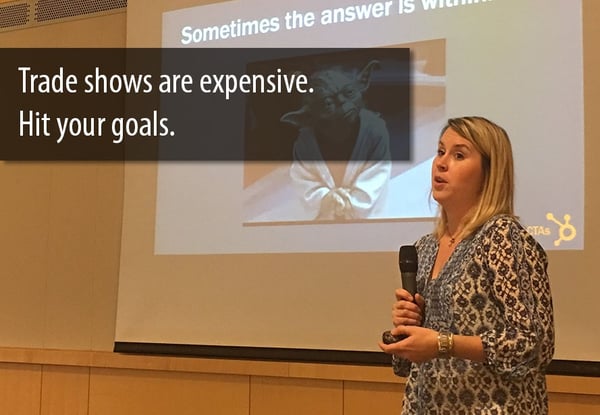
How much did your company spend at the last industry trade show?
I bet it was spendy.
That’s why Janna Erickson, Field Marketing Manager of HubSpot, keeps a close eye on the ROI of events.
“My goal is ROI,” she said at the Twin Cities HubSpot User Group gathering on September 7 at the Minneapolis Central Library. “Events are very expensive.”
As such, Erickson and her team focus on educating colleagues as to why certain events are important to attend, what their goals are for each event, and how everyone in the company can help her team reach those goals.
In her discussion with the group, Erickson provided 4 main steps to achieve success at your next trade show.
Step 1: Goals and Calls-to-Action
Identify your goals for the event. Are you trying to:
- Gain new leads and sales?
- Increase organic and direct traffic to your website?
- Increase your social media following?
- Generate new email or blog subscribers?
Once you have your goals established, you can concentrate on how to achieve the best trade show results through:
- Booth structure
- Wardrobe
- Contests and promotions
- Landing pages
- Signage
- Handouts and swag
The key, said Erickson, is to focus on an inbound approach during live events.
“You want to have interaction with booth visitors,” she said. “That way, you’re building a relationship.”
Rather than using scanners to collect contact information, Erickson suggested having dedicated landing pages for each event for people to actively volunteer information.
But don’t stop talking to them once they fill out the form, she added. Engage with them throughout the process.
For attendees on the move, you can also provide QR codes for access to your landing page. Don’t cringe. QR codes, although dated, are still useful on mobile devices.
As Erickson put it, “They’re hideous, but effective.”
Step 2: Promote the Trade Show
A self-described fan of Twitter (@BostonJanna), Erickson had the following suggestions for promoting an event on social media:
- Use the event hashtag
- Schedule posts leading up to the event
- Create an event page on Facebook and LinkedIn
- Create a video for YouTube
- Leverage any and all local event communities, such as local event boards
And don’t forget to coach your team on promoting the trade show using their own social media networks.
Encourage your team to follow the event hashtag, said Erickson, and educate them on the overall goals your company is trying to accomplish.
At the same time, ensure that everyone knows best practices for using social media as well as for promoting an event.
Step 3: Execute On-site
Erickson shared 7 tips for the best day-of execution:
1. Collect leads the inbound way
It may be the HubSpot talking, but Erickson’s point was to bring in leads by establishing a relationship rather than scanning a name tag. As a result, the leads will be more qualified and apt to speak with you after the event.
2. Connect with booth visitors
Don’t go into a pitch for your product or service. Instead, ask what the visitor’s challenge or opportunity is.
3. Make your booth welcoming
Smiles and a positive attitude are a must for events, said Erickson, even if you don’t always feel happy to be there.
4. Expect the unexpected“Plan for something to go wrong,” said Erickson. Cause something will. Just be sure to have a backup plan and open lines of communication with your team.
5. Don’t be afraid to make changesErickson debriefs with her team after the first day to make changes on the fly. They may be minor tweaks or significant issues that need to be addressed immediately.
6. Monitor social mediaSometimes, the best person to monitor social media during a live event is back at the office, said Erickson. Everyone is usually too busy to monitor hashtag streams while working the booth.
7. Keep your staff energizedIt may seem like a no-brainer, but it’s often overlooked when the excitement of an event rolls around -- let people take a break. Not only will they perform better while at the booth, said Erickson, they are also more likely to show up to their assigned shifts.
Step 4: Post-event Checklist
You may be exhausted from the show, and feeling the need to take some time off, said Erickson. But this is the time to go back to your original goals and ask yourself a couple of questions.
- First of all, did you achieve your goal?
- Secondly, how or why not?
- In addition to internal feedback from your team, it beneficial to reach out to contacts with a follow-up survey, if possible.
Some final tasks:
- In terms of leads generated from the show, get back to them within 24 hours, suggested Erickson. After that, touch base with them 2 weeks later.
- You should also reach out to leads who didn’t attend with a follow-up email, something along the lines of “sorry we missed you” to establish another touch point.
- As a final step in the process, Erickson encouraged everyone to create new content surrounding the event, such as a recap of what went down, why your company was there, or what you gained from the show “to keep the buzz of your event alive” well past the closing session.
What are your best trade show secrets? Let us in on some in the comments below and be sure to take part in the next Twin Cities HUG event on December 7, 2016.
Share this
You May Also Like
These Related Stories

How to Get ROI from Trade Shows & Events

Smart Content Case Study: Hyper-Personalized Newsletters


/Accreditations/CRM-Implementation-Accredited-Badges.png?width=170&height=138&name=CRM-Implementation-Accredited-Badges.png)
/Accreditations/Onboarding-Accredited-Badges.png?width=170&height=137&name=Onboarding-Accredited-Badges.png)
/Accreditations/Custom-Integration-Accredited-Badges.png?width=170&height=137&name=Custom-Integration-Accredited-Badges.png)

